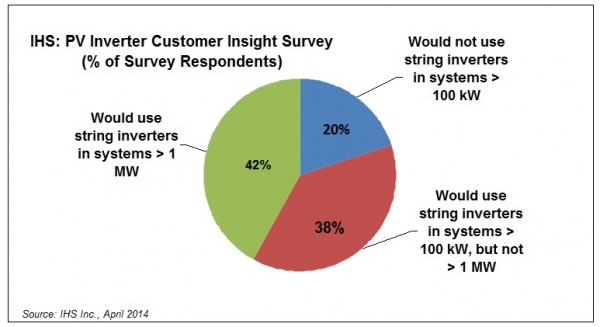PV inverter preferences changing says IHS
Post Date: 04 Apr 2014 Viewed: 316

One of IHS' key findings is that there is a growing acceptance of string inverters being considered for large-scale PV power plants above the 1MW size.
The PV inverter market continues to evolve with changing preferences and acceptance of Chinese producers products increasing, according to the latest survey of purchasers from market research firm, IHS.
One of IHS' key findings is that there is a growing acceptance of string inverters being considered for large-scale PV power plants above the 1MW size. According to the IHS survey, 40% of inverter buyers now consider string inverters over central inverters as they can offer better flexibility as well as a reduction in electricity losses.
“The survey confirmed that the acceptance of string inverters in large systems has accelerated over the last year, mirroring the IHS forecast that these products will gain share in several key PV markets,” said Cormac Gilligan, senior PV market analyst at IHS. “The most common reasons given for solar purchasers preferring string inverters increasingly over central inverters in large systems were better system design flexibility, minimising losses in the case of failure and lower lifetime system costs.”
According to IHS the survey, over 50% of buyers considered string inverters for large-scale PV projects, up from 17% in the previous survey. More than 300 solar installers, distributors and engineering, procurement and construction (EPC) companies were said to have participated in the survey.
This has led to IHS projecting that low power three-phase inverter shipments are expected to increase by 14% a year on average over the next four years, culminating in annual shipments of almost 20GW in 2017.
However, another major shift in purchasing behaviour is the growing acceptance of PV inverters produced by Chinese suppliers. Perceptions of lower quality and reliability are fading, according to the survey.
IHS said that Chinese-made inverters are increasingly popular in the US, UK and even Germany, noting that almost 60% of inverter buyers in the UK consider Chinese-made inverters to be of acceptable quality.
When buyers were asked the question, “Do you think Chinese inverters offer sufficient levels of quality?”, half answered yes. "This shows that the global level of acceptance for Chinese inverter suppliers has increased for a second consecutive year,” added Gilligan.
“The last two years have seen the United Kingdom transform quickly from a booming new market with a highly attractive feed-in tariff (FiT), to a steady-growth, low-cost region with lean subsidies,” Gilligan noted. “As a result of high price pressure in the UK, the country has become a strong focus for Chinese suppliers, which have been able to gain a foothold in Britain. The price declines in the UK have been driven by regular reductions to the FiT and the many systems being designed to meet minimum renewables requirements in new buildings at the lowest possible upfront cost.”
No surprises though that the IHS survey noted the continued gain in acceptance of microinverters in the market, highlighting that 42% of buyers surveyed use microinverters, with the US leading the way.
However, large acceptance gains are being recorded for the UK with over 50% of purchasers surveyed now use or buy microinverters instead of string inverters, primarily for residential rooftop markets.



